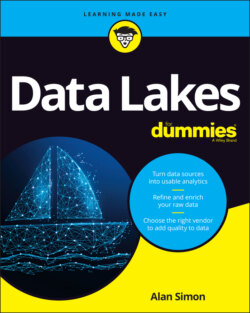Читать книгу Data Lakes For Dummies - Alan R. Simon - Страница 20
Semi-structured data: Stuck in the middle of the lake
ОглавлениеSemi-structured data sort of falls in between structured and unstructured data. Examples include a blog post, a social media post, text messages, an email message, or a message from Slack or Microsoft Teams. Leaving aside any embedded or attached images or videos for a moment, all these examples consist of a long string of letters, numbers, and special characters. However, there’s no particular structure assigned to most of these text strings other than perhaps a couple of lines of heading information. The body of an email may be very short — only a line or two — while another email can go on for many long paragraphs.
In your data lake, you need to have all these types of data sitting side by side. Why? Because you’ll be running analytics against the data lake that may need more than one form of data. For example, you receive and then analyze a detailed report of sales by department in a large department store during the past month.
Then, after noticing a few anomalies in the sales numbers, you pull up in-store surveillance video to analyze traffic versus sales to better understand how many customers may be looking at merchandise but deciding not to make a purchase. You can even combine structured data from scanners with your unstructured video data as part of your analysis.
If you had to go to different data storage environments for your sales results (structured data) and then the video surveillance (unstructured data), your overall analysis is dramatically slowed down, especially if you need to integrate and cross-reference different types of data. With a data lake, all this data is sitting side by side, ready to be delivered for analysis and decision-making.
In their earliest days, relational databases only stored structured data. Later, they were extended with capabilities to store structured and unstructured data. Binary large objects (BLOBs) were a common way to store images and even video in a relational database. However, even an object-extended relational database doesn’t make a good platform for a data lake when compared with modern data services such as Amazon S3 or Microsoft ADLS.
